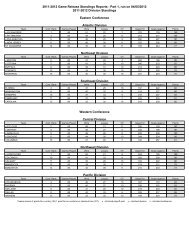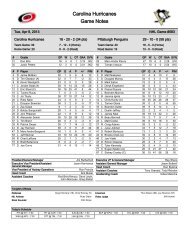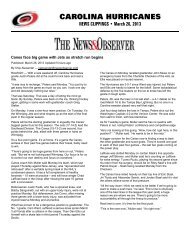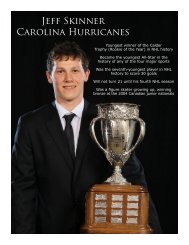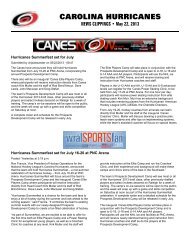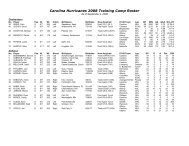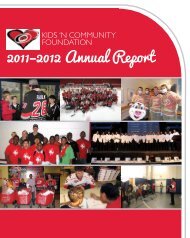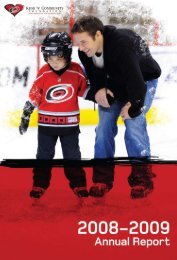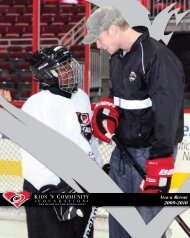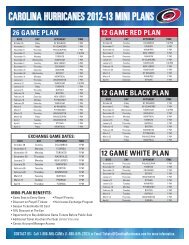2011-12 MEDIA GUIDE - Carolina Hurricanes - NHL.com
2011-12 MEDIA GUIDE - Carolina Hurricanes - NHL.com
2011-12 MEDIA GUIDE - Carolina Hurricanes - NHL.com
You also want an ePaper? Increase the reach of your titles
YUMPU automatically turns print PDFs into web optimized ePapers that Google loves.
MEDICAL GLOSSARY<br />
Abduction: Movement of a joint away from the center of the body.<br />
AC Joint (Acromioclavicular joint): Joint of the shoulder where acromion<br />
process of the shoulder blade and the distal end of the collarbone meet; most<br />
shoulder separations occur at this point.<br />
Adduction: Movement of a joint toward the center of the body.<br />
Adhesion: abnormal adherence of collagen fibers to surrounding structures during<br />
immobilization following trauma or as a <strong>com</strong>plication of surgery which restricts<br />
normal elasticity of the structures involved; or scar tissue which forms after trauma<br />
or surgery which can restrict normal motion.<br />
Aerobic: exercise in which energy needed is supplied by oxygen inspired and<br />
is required for sustained periods of vigorous exercise with a continually high<br />
pulse rate.<br />
Anabolic Steroids: Steroids that promote tissue growth by creating protein in<br />
an attempt to enhance muscle growth. The main anabolic steroid is testosterone<br />
(male sex hormone).<br />
Anaerobic: exercise without the use of oxygen as an energy source; short bursts<br />
of vigorous exercise.<br />
Anterior Cruciate Ligament (ACL): a primary stabilizing ligament within the<br />
center of the knee joint that prevents hyperextension and excessive rotation of the<br />
joint. a <strong>com</strong>plete tear of the aCL necessitating reconstruction could require up to<br />
<strong>12</strong> months of rehabilitation.<br />
Anti Inflammatory: any agent which prevents inflammation, such as aspirin<br />
or ibuprofen.<br />
Arteriogram: a film demonstrating arteries after injection of a dye.<br />
Arthrogram: X ray technique for joints using air and/or dye injected into the<br />
affected area; useful in diagnosing meniscus tears of the knee and rotator cuff<br />
tears of the shoulder.<br />
Arthroscope: an instrument used to visualize the interior of a joint cavity.<br />
Arthroscopy: a surgical examination of the internal structures of a joint by means<br />
of observation through an arthroscope. an arthroscopic procedure can be used to<br />
remove or repair damaged tissue or as a diagnostic procedure in order to inspect<br />
the extent of any damage or confirm a diagnosis.<br />
Atrophy: To shrivel or shrink from disuse; as in muscular atrophy.<br />
Baker’s Cyst: Localized swelling of a bursa sac in the back of the knee as a result<br />
of fluid that has escaped from the knee capsule. a Baker’s cyst indicates that there<br />
is a trauma inside the knee joint that leads to excessive fluid production.<br />
Bone Scan: an imaging procedure in which a radioactive labeled substance is<br />
injected into the body to determine the status of a bone injury. if the radioactive<br />
substance is taken up by the bone at the injury site, the injury will show as a ‘hot<br />
spot’ on the scan image. The bone scan is particularly useful in the diagnosis of<br />
stress fractures.<br />
Bursa: a fluid filled sac located in areas where friction is likely to occur. The bursa<br />
sac minimizes the friction, for example, between a tendon and bone.<br />
Cartilage: Smooth, slippery substance preventing two ends of bones from rubbing<br />
together and grating. Most joints use this to cover bones next to each other.<br />
a meniscus is made of cartilage.<br />
CAT Scan (Computerized Tomography): use of a <strong>com</strong>puter to produce a crosssectional<br />
view of the anatomical part being investigated from x ray data.<br />
Chondromalacia: Roughening of the articular cartilage. Best known for the<br />
roughening of the underside of the kneecap, which can occur in any kneecap injury.<br />
Clavicle: Collarbone; the bone connecting the breastbone with the shoulder blade.<br />
Closed Reduction: Re-alignment of a fracture or dislocation without surgery.<br />
Coccyx: The ‘tailbone,’ a group of four vertebrae that are fused together to form a<br />
small triangular bone, located at the terminal end of the spine.<br />
Concussion: Jarring injury of the brain resulting in dysfunction. it can be graded<br />
as mild, moderate or severe, depending on loss of consciousness, amnesia and loss<br />
of equilibrium.<br />
Contusion: an injury to a muscle and tissues caused by a blow from a blunt object.<br />
Corticosteroids: used to suppress joint inflammation and inflammation in a bursa<br />
or near tendons.<br />
Cryotherapy: a treatment with the use of cold.<br />
Cyst: abnormal sac containing liquid or semi solid matter.<br />
Degenerative Joint Disease: Changes in the joint surfaces as a result of repetitive<br />
trauma and ‘wear and tear’.<br />
262 / <strong>2011</strong>-<strong>12</strong> Media Guide<br />
Deltoid Ligament: Ligament that connects the tibia to bones of the medial aspect<br />
of the foot and is primarily responsible for stability of the ankle on the medial side.<br />
is sprained less frequently than other ankle ligaments.<br />
Deltoid Muscle: Muscles at the top of the arm, just below the shoulder, responsible<br />
for shoulder motions in the front, side and back.<br />
Disc, Intervertebral: a flat, rounded plate between each vertebrae of the spine.<br />
The disc consists of a thick fiber ring which surrounds a soft gel like interior. it<br />
functions as a cushion and shock absorber for the spinal column.<br />
Dislocation: Complete displacement of joint surfaces.<br />
Electromyogram (EMg): Test to determine nerve function.<br />
Epiconondylitis: inflammation of tendons at the elbow due to overuse. Common in<br />
tennis players (outer part of elbow) and golfers (inner part of elbow).<br />
Etiology: Study of the cause of injury and disease.<br />
Extension: action of straightening of a joint as achieved by an extensor muscle.<br />
fascia: a connective tissue sheath consisting of fibrous tissue and fat which unites<br />
the skin to the underlying tissue.<br />
fat Percentage: The amount of body weight that is adipose, fat tissue. Fat<br />
percentage can be calculated by underwater weighing, measuring select skinfold<br />
thickness or by analyzing electrical impedance.<br />
femur: Thighbone; longest bone in the body.<br />
fibula: Smaller of the two bones in the lower leg; runs from the knee to the ankle<br />
along the outside of the lower leg.<br />
flexibility: The ability of muscle to relax and yield to stretch forces.<br />
fracture: Breach in continuity of a bone. Types of fractures include simple,<br />
<strong>com</strong>pound, <strong>com</strong>minuted, greenstick, in<strong>com</strong>plete, impacted, longitudinal, oblique,<br />
open, stress or transverse.<br />
glenohumeral: The shoulder girdle; consists of the glenoid capsule, head of the<br />
humerus and labrum.<br />
glenoid: Cavity of the scapula into which the head of the humerus fits to form the<br />
shoulder girdle.<br />
glenoid Labrum: a rim of fibrocartilaginous tissue attached around the margin of<br />
the glenoid fossa.<br />
grade One Injury: a mild injury in which ligament, tendon or other musculoskeletal<br />
tissue may have been stretched, but not torn or otherwise disrupted.<br />
grade Two Injury: a moderate injury in which musculoskeletal tissue has been<br />
partially, but not totally torn, causing appreciable limitation in function of the<br />
injured tissue.<br />
grade Three Injury: a severe injury in which tissue loss has been significant,<br />
and in many cases, totally torn or otherwise disrupted, causing a virtual loss<br />
of function.<br />
groin: Junction of the thigh and abdomen, location of muscles that rotate, flex and<br />
adduct the hip.<br />
Hammer Toe: Condition when the first digit of a toe is at a different angle than the<br />
remaining digits of the same toe.<br />
Hamstring: Category of muscle that runs from the buttocks to the knee along the<br />
back of the thigh. it functions to flex the knee and is often times injured as a result<br />
of improper conditioning or lack of muscle flexibility.<br />
Hemarthrosis: accumulation of blood within a joint as a result of an acute injury.<br />
Hematoma: Mass produced by an accumulation of coagulated blood in a cavity or<br />
in soft tissues.<br />
High Ankle Sprain: disruption of thick connective tissue between the tibia and<br />
fibula above the ankle joint.<br />
Hip Pointer: Contusion to the iliac crest.<br />
Hydrotherapy: Treatment using water.<br />
Hyperextension: extreme extension of a limb or body part.<br />
Ice and Stimulation: use of ice to reduce inflammation and muscle stimulation by<br />
surface electrodes to maintain muscle strength used in rehabilitation of injury.<br />
Iliotibial Band: a thick, wide fascial layer that runs from the iliac crest to the knee<br />
joint on the outside of the thigh.<br />
Inflammation: The body’s natural response to injury in which the injury site might<br />
display various degrees of pain, swelling, heat, redness and/or loss of function.<br />
Isometric Contraction: Muscular contraction in which tension is developed but<br />
no mechanical work is done.




